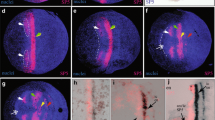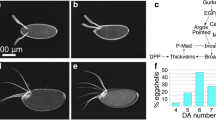Abstract
The embryonic development of the primordia of the Drosophila head was studied by using an enhancer trap line expressed in these structures from embryonic stage 13 onward. Particular attention was given to the question of how the adult head primordia relate to the larval head segments. The clypeo-labral bud to the stage 13 embryo is located at a lateral position in the labrum adjacent to the labral sensory complex (“epiphysis”). Both clypeo-labral bud and sensory complex are located anterior to the engrailed-expression domain of the labrum. Throughout late embryogenesis and the larval period, the clypeo-labral bud forms integral part of the epithelium lining the roof of the atrium. The labial disc originates from the lateral labial segment adjacent to the labial sensory complex (“hypophysis”). It partially overlaps with the labial en-domain. After head involution, the labial disc forms a small pocket in the ventro-lateral wall of the atrium. The eye-antenna disc develops from a relatively large territory occupying the dorso-posterior part of the procephalic lobe, as well as parts of the dorsal gnathal segments. Cells in this territory are greatly reduced in number by cell death during stages 12–14. After head involution, the presumptive eye-antenna disc occupies a position in the lateral-posterior part of the dorsal pouch. Evagination of this tissue occurs during the first hours after hatching. In the embryo, no en-expression is present in the presumptive eye-antenna disc. en-expression starts in three separate regions in the third instar larva.
Similar content being viewed by others
References
Bate M, Martinez-Arias A (1991) The embryonic origin of imaginal discs in Drosophila. Development 112:755–761
Bier E, Vaessin H, Shepherd S, Lee K, McCall K, Barbel S, Ackerman L, Carretto R, Uemura T, Grell E, Jan LY, Jan YN (1989) Searching for pattern and mutation in the Drosophila genome with a P-lacZ vector. Genes & Development 3, 1273–1287
Bryant PJ (1978) Pattern formation in imaginal discs. In: Ashburner M, Wright TRF (eds) The genetics and biology of Drosophila, vol 2c. Academic Press, London, New York & San Francisco, pp 229–335
Campos-Ortega JA, Hartenstein V (1985) The Embryonic Development of Drosophila melanogaster. Springer, Berlin Heidelberg New York
Chen TY (1929) On the development of imaginal buds in normal and mutant Drosophila melanogaster. J Morphol 47:135–199
Diederich RJ, Pattatucci AM, Kaufman TC (1991) Developmental and evolutionary implications of labial, deformed and engrailed expression in the Drosophila head. Development 113:273–281
DiNardo S, Kuner JM, Theis J, O'Farrell PH (1985) Development of embryonic pattern in Drosophila melanogaster as revealed by accumulation of the nuclear engrailed protein. Cell 43:59–69
Eassa YEE (1953) The development of imaginal buds in the head of Pieris brassicae Linn. (Lepidoptera). Trans R Ent Soc Lond 104:39–51
Ferris GF (1950) External Morphology of the Adult. In: Demerec M (ed) Biology of Drosophila. Wiley, New York, pp 368–419
Garcia-Bellido A, Merriam JR (1969) Cell lineage of the imaginal discs in Drosophila gynandromorphs. J Exp Zool 170:61–67
Gehring WJ, Seippel S (1967) Die Imaginalzellen des Clypeo-Labrums und die Bildung des Rüssels von Drosophila melanogaster. Rev Suisse Zool 74:589–596
Hama C, Ali Z, Kornberg TB (1990) Region-specific recombination and expression are directed by portions of the Drosophila engrailed promoter. Genes Dev 4:1079–1093
Hartenstein V (1988) Development of Drosophila larval sensory organs: spatiotemporal pattern of sensory neurones, peripheral axonal pathways and sensilla differentiation. Development 102:869–886
Hartenstein V, Jan YN (1992) Studying Drosophila embryogenesis with P-lacZ enhancer trap lines. Roux's Arch Dev Biol 201:194–220
Haynie JL, Bryant PJ (1986) Development of the eye-antenna imaginal disc and morphogenesis of the adult head in Drosophila melanogaster. J Exp Zool 237:293–308
Jurgens G, Lehmann R, Schardin M, Nüsslein-Volhard C (1986) Segmental organization of the head in the embryo of Drosophila melanogaster. A blastoderm fate map of the cuticle structures of the larval head. Roux's Arch Dev Biol 195:359–377
Jürgens G, Hartenstem V (1993) The Terminal Regions of the Body Pattern. In: Bate M, Martinez-Arias A (eds) The development of Drosophila. Cold Spring Harbor Laboratory Press (in press)
Kellog VL (1902) The development and homologies of the mouth parts of insects. Am Naturalist 36:683–706
Kuhn DT, Sawyer M, Packert G, Turenchalk G, Mack JA, Sprey TE, Gustavson E, Kornberg TB (1992) Development of the D. melanogaster caudal segments involves supression of the ventral regions of A8, A9 and A10. Development 116:11–20
Madhavan MM, Schneiderman HA (1977) Histological analysis of the dynamics of growth of imaginal discs and histoblast nests during the larval development of Drosophila melanogaster. Roux's Arch Dev Biol 183:269–305
Mitchison TJ, Sedat J (1983) Localization of antigenic determinants in whole Drosophila embryos. Dev Biol 99:261–264
Morata G, Lawrence PA (1979) Development of the eye-antenna imaginal disc of Drosophila. Dev Biel 70:355–371
Paulus HF (1989) Das Homologisieren in der Feinstrukturforschung: Das Bolwig Organ der hoeheren Dipteren und seine Homologisierung mit Stemmata und Ommatidien eines urspruenglichen Facettenauges der Mandibulata. Zool Beitr N F 32:437–478
Poulson DF (1950) Histogenesis, organogenesis, and differentiation in the embryo of Drosophila melanogaster (Meigen). In: Demerec M (ed) Biology of Drosophila. Wiley, New York, pp 168–274
Rempel JG (1975) The evolution of the insect head: the endless dispute Quaest Entomol 11:7–25
Schmidt-Ott U, Technau GM (1992) Expression of en and wg in the embryonic head and brain of Drosophila indicates a refolded band of seven segment remnants. Development 116:111–125
Schoeller J (1964) Recherches descriptives et experimentales sur la céphalogénèse de Calliphora erythrocephala (Meigen) au cours des développements embryonnaire et postembryonnaire. Arch Zool Exp Gen 103:1–216
Snodgrass RE (1935) Principles of Insect Morphology. McGrawHill, New York, pp 311–315
Spreij TR (1971) Cell death during the development of the imaginal discs of Calliphora erythrocephala. Netherlands J Zool 21:221–264
Strindberg H (1913) Embryologische Studien an Insekten. Z Wiss Zool 106:1–227
Struhl G (1981a) A blastoderm fate map of compartments and segments of the Drosophila head. Dev Biol 84:386–396
Struhl G (1981b) Anterior and posterior compartments in the proboscis of Drosophila. Dev Biol 84:372–385
Tepass U, Theres C, Knust E (1990) Crumbs encodes an EGF-like protein expressed on apical membranes of Drosophila epithelial cells and required for organization of epithelia. Cell 61:787–799
Tepass U, Knust E (1990) Phenotypic and developmental analysis of mutations at the crumbs locus, a gene required for the development of epithelia in Drosophila melanogaster. Roux's Arch Dev Biol 199:189–206
Viallanes MH (1882) Recherches sur l'histologie des insectes et sur les phenomenes histologiques qui accompagnent le developpement postembryonnaire de ces animaux. Ann Sci Nat Ser 6 (Zool) 14 Art 1:1–348
Wieschaus E, Gehring WJ (1976) Clonal analysis of primordial disc cells in the early embryo of Drosophila melanogaster. Dev Biol 50:249–263
Wolff T, Ready DF (1991) Cell death in normal and rough eye mutants of Drosophila. Development 113:825–839
Zalokar M, Erk I (1977) Phase-partition fixation and staining of Drosophila eggs. Stain Technol 52:89–95
Author information
Authors and Affiliations
Rights and permissions
About this article
Cite this article
Younossi-Hartenstein, A., Tepass, U. & Hartenstein, V. Embryonic origin of the imaginal discs of the head of Drosophila melanogaster. Roux's Arch Dev Biol 203, 60–73 (1993). https://doi.org/10.1007/BF00539891
Received:
Accepted:
Issue Date:
DOI: https://doi.org/10.1007/BF00539891




